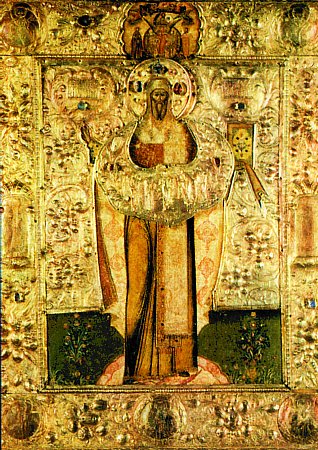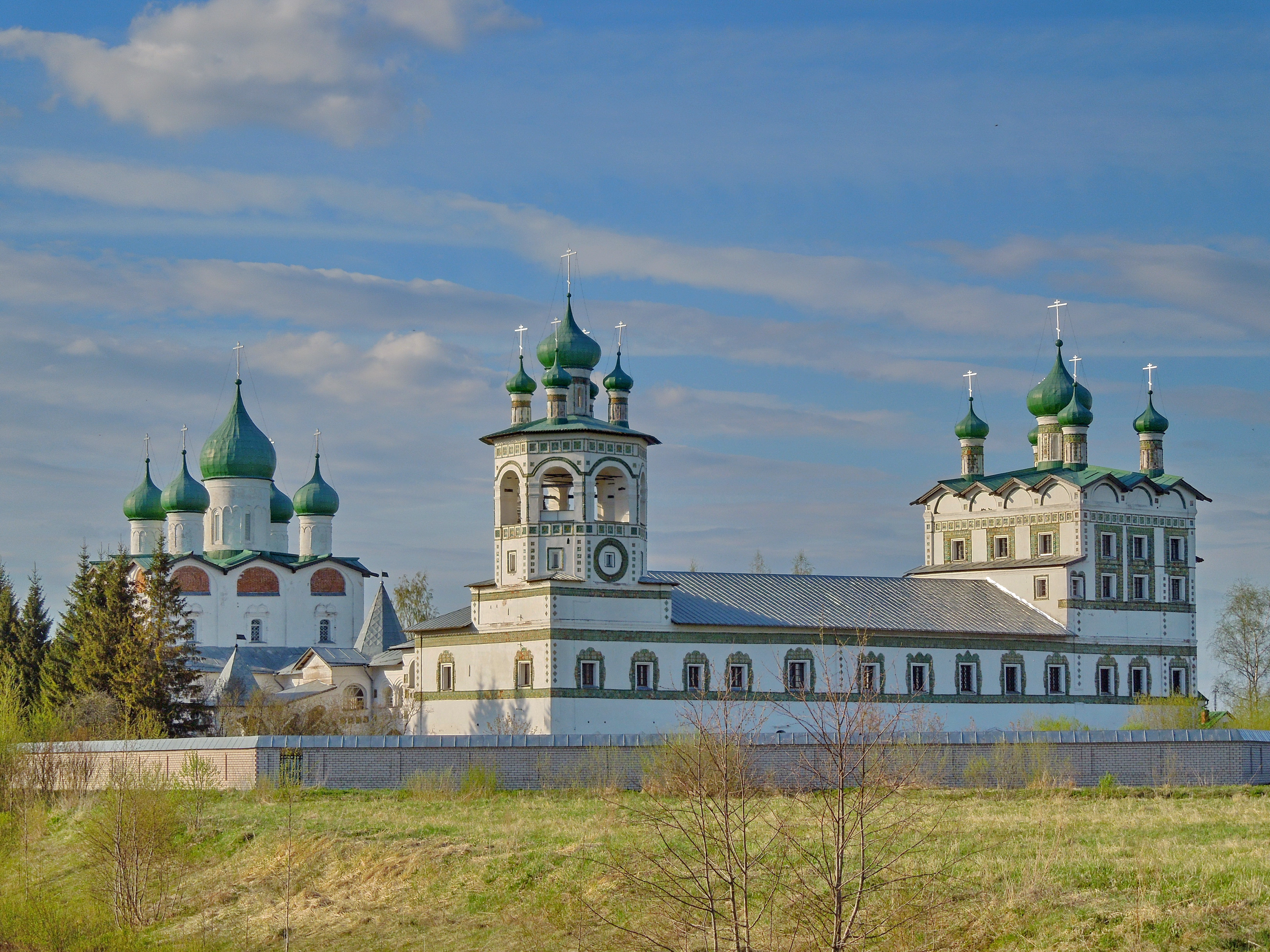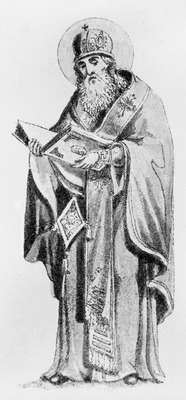|
Euthymius II Of Novgorod
Evfimy II, Archbishop of Novgorod the Great and Pskov from 1429 to 1458, was one of the most prolific patrons of the arts and architecture of all the Novgorodian archbishops. His Background According to his saint's lives, Evfimy's baptismal name was Ioann or Ivan and he was the son of a priest Fedor, and his wife, Anna, although some saint's lives give his father's name as Mikheia, and say he was the priest of the Church of St. Fedor the Great Martyr on the Market side of the city (today it is just east of the Aleksandr Nevsky Bridge on the main road running east out of the city. His Monastic and Archiepiscopal Life He was shorn a monk at the Listitsa Hill Monastery (Listitsky) and later transferred to the Vyazhishchsky Monastery 12 miles (7 km) northwest of Novgorod (he is known as Evfimy Viazhishchskii for this reason). He was elected archbishop by the veche after the death of his predecessor Evfimy I (Bradatii) in 1429 but was not consecrated until 1434, and not in Moscow ... [...More Info...] [...Related Items...] OR: [Wikipedia] [Google] [Baidu] |
Archbishop Of Novgorod
The Diocese of Novgorod (russian: Новгородская епархия) is one of the oldest offices in the Russian Orthodox Church. The medieval archbishops of Novgorod were among the most important figures in medieval Russian history and culture and their successors (as bishops, archbishops, or metropolitans) have continued to play significant roles in Russian history up to the present day. They patronized a significant number of churches in and around the city, (several of which can still be seen today), and their artistic and architectural embellishments influenced later Russian art and architecture; they also patronized chronicle-writing, a crucial source on medieval Russian history. The Republican period The office of bishop of Novgorod was created around the time of the Christianization of Rus' (988), although the chronicles give conflicting dates for its establishment ranging anywhere from 989 to 992. The first bishop, Ioakim Korsunianin (ca. 989-1030), built the ... [...More Info...] [...Related Items...] OR: [Wikipedia] [Google] [Baidu] |
Vyazhishchsky Monastery
The Vyazhishchi Convent of St. Nicholas (''Nikolo-Vyazhishchsky Stavropegial Women's Monastery''; russian: Николо-Вяжищский ставропигиальный монастырь) is an Orthodox convent located in the village of Vyazhishchi, 7 miles (12 km) NNW of Veliky Novgorod. Its surviving buildings date from the period between 1681 and 1708. They are famous for having the richest maiolica decorations in Northwest Russia. The monastery was founded by the monks Efrosiny, Ignaty, and Galaktion and the hieromonk Pimen at the end of the fourteenth century (a charter from 1391 mentions it), with Pimen becoming the first hegumen of the monastery. It was first mentioned in the chronicle in the year 1411. The monastery was patronized by Archbishop Evfimy II (r. 1429-1458), who was hegumen of the monastery before his election as archbishop of Novgorod in 1429, and was buried there (he is known as St. Evfimy of Vyazhishche).Novgorodskaia Vtoraia Letopis (PSRL 3), 241. ... [...More Info...] [...Related Items...] OR: [Wikipedia] [Google] [Baidu] |
Veche
Veche ( rus, вече, véče, ˈvʲet͡ɕe; pl, wiec; uk, ві́че, víče, ; be, ве́ча, viéča, ; cu, вѣще, věšte) was a popular assembly in medieval Slavic countries. In Novgorod and in Pskov, where the veche acquired great prominence, the veche was broadly similar to the Norse ''thing'' or the Swiss Landsgemeinde. Etymology The word is inherited from Proto-Slavonic *''větje '', meaning 'council', 'counsel' or 'talk' (which is also represented in the word "soviet", both ultimately deriving from Proto-Slavic verbal stem of *větiti 'to talk, speak'). There is a relation to "-vice" in "advice", and somewhat more distantly to Sanskrit "Veda", Germanic words like "wise" (English), "weten" (Dutch, "to know"), "witch" (Slavonic: ''věšt-ica'') and many others, which however come from a different Indo-European root. Likewise, there exists misinformation claiming that the semantic derivation that yields the meaning of the word under consideration is paralle ... [...More Info...] [...Related Items...] OR: [Wikipedia] [Google] [Baidu] |
Saint Sophia Cathedral In Novgorod
The Cathedral of Holy Wisdom (the Holy Wisdom, Holy Wisdom of God) in Veliky Novgorod is the cathedral church of the Archbishop of Novgorod, Metropolitan of Novgorod and the mother church of the Novgorodian Eparchy. History The 38-metre-high, five-domed, stone cathedral was built by Vladimir of Novgorod and Bishop Luka Zhidiata between 1045 and 1050 to replace an oaken cathedral built by Bishop Ioakim Korsunianin in the late tenth century (making it the oldest church building in Russia proper and, with the exception of the Zelenchuk churches, Arkhyz and Shoana Church, Shoana churches, the oldest building of any kind still in use in the country). It was consecrated by Bishop Luka Zhidiata (1035–1060) on September 14, in 1050 or 1052, the feast of the Feast of the Cross, Exaltation of the Cross. (A fresco just inside the south entrance depicts Sts. Constantine and Helena, who found the true cross in the fourth century; it is one of the oldest works of art in the cathedral and ... [...More Info...] [...Related Items...] OR: [Wikipedia] [Google] [Baidu] |
Ilya (Archbishop Of Novgorod)
Ilya of Novgorod, also known as Ioann (John) of Novgorod (russian: Иоанн Новгородский, his name upon entering the Great Schema and the name by which he is known in Russian Orthodox hagiography), was Archbishop of Novgorod from 1165 to his death in 1186. Life The son of a priest, Ilya was himself priest of the Church of St. Blaise, south of the Novgorod Kremlin. The church was destroyed, rebuilt in 1407, destroyed during the Second World War and rebuilt again. Ilya was probably his first monastic name, and his baptismal name is not known. Ilya was appointed bishop of Novgorod by Metropolitan Ioann of Kiev in 1165. He was the first to hold the title of archbishop in Novgorod after the office was elevated to the archiepiscopal dignity a few months later. Niphont held the title as a personal honor. Ilya carried out a number of construction projects in Novgorod along with his brother, Gavril (also known as Grigorii), who succeeded him as archbishop (1186–119 ... [...More Info...] [...Related Items...] OR: [Wikipedia] [Google] [Baidu] |
Pachomius The Serb
Pachomius the Serb (russian: Пахомий Серб, sr, Пахомије Србин), also known as Pachomius Logothetes, russian: Пахомий Логофет, el, Παχώμιος Λογοθέτης) was a 15th-century Serbian hagiographer who, after taking monastic vows, was schooled on Mount Athos and mastered the ornate style of medieval Serbian literature.G. M. Prokhorov, “Pakhomii Serb,” in D. S. Likhachev, ''Slovar’ knizhnikov i knizhnosti Drevnei Rusi'', vol. 2, Pervaia polovina XIV-XVI v., pt. 2. He is credited by the Russian Early Texts Society for the Serbian version of Barlaam and Josaphat from Old Greek. In the 1450s and 1460s he resided at the Trinity Monastery of St. Sergius north of Moscow. One of his major undertakings was a Russian translation of the New Testament. In about 1470 Archbishop Jonas (Iona) asked him to settle in Novgorod where he prepared a set of the lives of local saints. It has been suggested that ''The Tale of the Princes of Vladimir ... [...More Info...] [...Related Items...] OR: [Wikipedia] [Google] [Baidu] |
Khutyn Monastery
Khutyn Monastery of Saviour's Transfiguration and of St. Varlaam (russian: Хутынский Спасо-Преображенский Варлаамиев монастырь) is an Orthodox monastery situated on the right bank of the Volkhov River some 10 km north northeast of Novgorod, in the village of Khutyn. It used to be one of the main Christian shrines of the medieval Novgorod Republic. The cloister was founded in 1192 by the monastery's first hegumen, the former Novgorodian boyar Oleksa Mikhailovich, whose monastic name was Varlaam. The main church of the monastery was consecrated by Archbishop Gavril of Novgorod the following year, the same year Varlaam died. He is buried in the main church of the monastery, the Church of the Transfiguration, to the right of the altar. He was the patron saint of Novgorod and the patrilineal ancestor of many families of Russian nobility, including Chelyadnins and Pushkins, of which Alexander Pushkin was a member. According to Va ... [...More Info...] [...Related Items...] OR: [Wikipedia] [Google] [Baidu] |
Vasily II
Vasily Vasiliyevich (russian: Василий Васильевич; 10 March 141527 March 1462), also known as Vasily II the Blind (Василий II Тёмный), was the Grand Prince of Moscow whose long reign (1425–1462) was plagued by the greatest civil war of Old Russian history. At one point, Vasily was captured and blinded by his opponents, yet eventually managed to reclaim the throne. Due to his disability, he made his son, Ivan III the Great, his co-ruler in his late years. First ten years of internecine struggle Vasily II was the youngest son of Vasily I of Moscow by Sophia of Lithuania, the only daughter of Vytautas the Great, and the only son to survive his father (his elder brother Ivan died in 1417 at the age of 22). On his father's death Vasily II was proclaimed Grand Duke at the age of 10. His mother acted as a regent. His uncle, Yuri of Zvenigorod (Prince of Galich-Mersky), and his two sons, Vasily the Cross-Eyed and Dmitry Shemyaka, seized on the opportunity ... [...More Info...] [...Related Items...] OR: [Wikipedia] [Google] [Baidu] |
Treaty Of Yazhelbitsy
The Treaty of Yazhelbitsy (russian: Яжелбицкий мирный договор) was a peace treaty signed by Vasili II, Grand Prince of Moscow and Vladimir, and the government of Novgorod the Great in the village of Yazhelbitsy in February 1456. This treaty was a significant setback for Novgorod, which would culminate, almost quarter of a century later, in the city being brought under the direct control of the Muscovite Grand Prince in 1478. In 1456, the Novgorodians sustained a crushing defeat at the hands of the Muscovite forces at the end of a long succession struggle in which Grand Prince Vasily II triumphed over his cousin, Prince Dmitry Shemyaka; Shemyaka himself had been poisoned in Novgorod in 1453 probably at the hands of grand princely agents, although some scholars suggest that Archbishop Evfimy II (1429–1458) had him poisoned as a liability to Novgorodian interests. Shemyaka's widow had subsequently fled to the Grand Duchy of Lithuania with her son, Ivan Dmi ... [...More Info...] [...Related Items...] OR: [Wikipedia] [Google] [Baidu] |
Gennady (Archbishop Of Novgorod)
Gennadius (Gennady, russian: Геннадий; died 4 December 1505) was Archbishop of Novgorod the Great and Pskov from 1484 to 1504. He was most instrumental in fighting the Heresy of the Judaizers and is famous for compiling the first complete codex of the Bible in Slavic in 1499, known as the Gennady Bible. Gennady is a saint of the Russian Orthodox Church. His feast day is 4 December OS/17 December in the Gregorian Calendar. Biography Gennady was from the Gonzov boyar clan of Moscow and was, prior to his archiepiscopate, hegumen of the Chudov Monastery in the Moscow Kremlin. His immediate predecessor in Novgorod, Sergei, served less than a year. Sergei was recalled and confined to the Chudov Monastery apparently due to mental illness. Gennady was named Archbishop of Novgorod in Moscow and placed in office on 12 December 1484, the first Novgorodian prelate not chosen by lots since 1359. He arrived in Novgorod in January 1485 with the task (as had been Sergei's) of bring ... [...More Info...] [...Related Items...] OR: [Wikipedia] [Google] [Baidu] |



